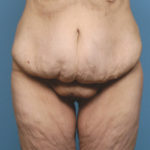
When I talk about complications from body contouring surgery, it is important to clarify what procedures we are talking about. Smaller procedures, such as necklifts, breast lifts, or armlifts, have less risk of complications that body lifts or thigh lifts. It is simply a matter of how long are the incisions and how much surgery was done. Body lifts, example, have a much longer incision and is a bigger operation than an arm lift for example. The point being….not all body contouring surgery procedures have the same risk of complications as others. You need to discuss with your plastic surgeon the different procedures you are having and how these risks differ. Suffice it to say, the more procedures that are done together the more incisions are made. As more incisions are made, the following potential risks are more likely.
By far, the most significant ‘complications’ from body contouring surgery are wound related. And they are as follows; incision/wound separation, seroma formation, and infection. Some slight or partial separation of certain incisions is likely and happens in many patients. These usually are at areas of high tension (tight skin closure) and or at the ‘T’ intersection of many procedures. (e.g., breast lift/reduction, combined horizontal/vertical abdominoplasty, above the gluteal crease in the body lift) When they happen, little can be done to close them except the allowance of time for healing in on their own.
Seromas, or fluid collections, are remarkably common. This is why we use drains after surgery. In my experience, 30% or so of patients who get drains will still develop a seroma after the drain has been removed. While no one dies from a seroma, it is inconvenient as the fluid must be ‘tapped’ with a needle and removed numerous times before it stops building up. While the use if drains helps eliminate many seromas that would otherwise form, it is not an absolute cure for them.
Infections occur in many body contouring patients although most of them are small and very limited. Most commonly, some stitches will spit later even if they are of the dissolveable type. This often makes a nice-looking and healing incision turn unsavory for a while. Mild infection and cellulitis of some skin areas can also occur but usually resolves with antibiotics alone.
Body contouring surgery patients need to know that they all will likely develop some of these issues. Once one gets past four to six weeks after surgery, the risk of these issues has passed and attention turns toward how the result looks.
Dr. Barry Eppley
Indianapolis, Indiana


